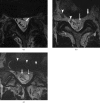Intracranial transthecal subarachnoid fat emboli and subarachnoid haemorrhage arising from a sacral fracture and dural tear
- PMID: 20139244
- PMCID: PMC3487252
- DOI: 10.1259/bjr/66268641
Intracranial transthecal subarachnoid fat emboli and subarachnoid haemorrhage arising from a sacral fracture and dural tear
Abstract
We present the case of a 28-year-old man with an unusual aetiology of lipid-dense material in the subarachnoid space. CT of the head at presentation was normal. MRI of the spine revealed a defect in the dura at L5/S1, with avulsed left L5 and S1 nerve roots. Haematoma and marrow fat were observed in close relation to the dural tear adjacent to the sacral fracture. Head CT and MRI subsequently demonstrated new lipid-dense material and haemorrhage in the subarachnoid space after sacral instrumentation, presumably owing to transthecal displacement of fatty marrow.
Figures



References
Publication types
MeSH terms
LinkOut - more resources
Full Text Sources
Medical

